Introduction
In this presentation I’ll show how…
“It’s impossible for a new property to outperform an old one, all other things being equal”
I’ll show how the historical data supports what the maths predicted. And I’ll cover all those pointless arguments that pushers of “new property” like to bring up, namely…
- Depreciation
- Stamp duty savings
- Rent
- Vacancy
- Repairs and maintenance
- Government grants
Depreciation
One of the biggest marketing angles used to sell new properties to investors is the “high depreciation benefits”. Note that depreciation is the opposite of appreciation and appreciation is another word for capital growth. There’s the 1st alarm bell.
Example
I’ll compare 2 properties, A and B. A is old and B is new. Here’s how we start off the comparison:
- Property A - old
- Total value: $500,000
- Land value: $300,000
- Building value: $200,000
- Total value: $500,000
- Property B - new
- Total value: $500,000
- Land value: $200,000
- Building value: $300,000
- Total value: $500,000
Both properties are the same value. But the property with the most depreciation “benefits” is property B, the new one. It has a brand-new dwelling which cost $300,000 to build. Whereas property A has an older dwelling with not nearly as much depreciation left in it – it might be around 10 years old.
Land appreciates
Assume 7 years have passed and the land for both properties doubled.
- 7 years later
- Property A – established
- Land value doubled from $300k to $600k
- Property B - new
- Land value doubled from $200k to $400k
The established property’s land would now be worth $600,000. It doubled from $300,000. The new
Buildings depreciate
Let’s assume that both properties depreciated at the same rate by a total of 20%.
- 7 years later
- Property A - established
- Building value from $200k to $160k
- Property B - new
- Building value from $300k to $240k
Note that new dwellings depreciate much faster than older ones. In fact, really old dwellings barely depreciate at all. Here’s the new values for A and B:
- 7 years later
- Property A - established
- New land value: $600k
- New building value: $160k
- New value: $760k
- Property B - new
- New land value: $400k
- New building value: $240k
- New value: $640k
Both were the same price, had the same rate of appreciation and the same rate of depreciation over the same time frame. Yet the difference is a staggering $120,000 in just 7 years.
- Property A - established
- Up 52%
- Property B - new
- Up 28%
But it’s actually not that extreme if we consider tax.
Tax
The owner of A has only been able to claim at most $40,000 in depreciation – and probably less since it was an established property and has different rules about depreciation claims. Let’s assume they’re only able to claim half of the depreciation loss - $20,000.
But how much you claim in depreciation isn’t money in the bank. It simply comes off your taxable income so you get taxed at a lower rate. Let’s assume a high marginal tax rate of 40% to maximise the tax saving.
- 7 years later
- Property A - established
- Building value at start: $200,000
- Building value at end: $160,000
- Claim only half = $20,000 depreciation
- 40% x $20,000 = tax saving of $8,000
- Property B - new
- Building value at start: $300,000
- Building value at end: $240,000
- Claim ALL $60,000 depreciation
- 40% x $60,000 = tax saving of $24,000
The owner of B (new) paid $16,000 less tax than the owner of A (old). So, instead of owner A being better off by $120k, they’re actually only better off by $104k after considering depreciation.
BTW, if you claim $10,000 in depreciation and you’re paying tax at 40c in the dollar, you would pay $4,000 less tax. But you’re not better off by $4,000. You’re actually worse off by $6,000. Your property has depreciated by $10,000 and you’ve claimed that loss. After tax the loss is not as bad, but it’s still a loss. Depreciation is not something an investor wants more of. It’s something they should try to minimise.
And note that it gets worse for the new property buyer if they ever decide to sell. Every cent claimed in depreciation over the life of ownership gets taken off the cost base when you sell. That means you end up paying more capital gains tax. Most of those tax savings are clawed back by the ATO in capital gains tax.
Now, don’t get me wrong, I’m not saying you shouldn’t claim depreciation if you can. What I am saying is that you can identify better investments by how little depreciation you can claim.
“The higher the depreciation, the worse an investment it is”
Cash-flow
Older properties will have higher maintenance expenses than newer properties. And newer properties may have higher rental income than older properties.
- 7 years later
- Property A - established
- Higher expenses by $1,500 p.a. for 7 years = $10,500
- Property B - new
- Higher rent by $30/week for 7 years = $10,920
This has closed the gap by over $20,000, but it’s still well in favour of the old property by about $80,000.
Oh, and there’s something else I didn’t consider. Those higher maintenance costs that the older property incurs are tax deductible. So, the government will ease the burden by the percentage of your marginal tax rate.
To borrow from the marketing madness of developers, I guess we’d be intitled to call these, “high maintenance benefits”.
Renovate or rebuild
Eventually, an old property will need a thorough renovation or even a complete rebuild. But in these cases, the profit goes in your pocket, not theirs.
“You’re not paying ‘cost’ when you buy new, you’re paying cost + developer profit”
The value you add by a renovation or rebuild is your profit. When you buy new, that profit goes to the developer (and their business partners) and the GST goes to the ATO.
Vacancy
Now some would argue that new properties are in higher demand by tenants and therefore suffer from lower vacancies. Others claim that because new properties are released in a large bunch, there is competition for tenants among landlords and they have higher vacancies. At most it’s only going to change the gap by a few thousand dollars over several years.
Putting it all together:
- 7 years later
- Property A - established
- Total value: $760,000
- Land value: $600,000
- Building value: $160,000
- Claim $20,000 depreciation (probably more)
- 40% x $20,000 = tax saving of $8,000
- Higher expenses by $1,500 p.a. for 7 years = $10,500
- $260k cap gain + $8k depr - $10.5k extra expenses = $257.5k
- Property B - new
- Total value: $640,000
- Land value: $400,000
- Building value: $240,000
- Claim $60,000 depreciation
- 40% x $60,000 = tax saving of $24,000
- Total after tax gain = $164,000
- Higher rent by $30/week for 7 years = $10,920
- $140k cap gain + $24k depr + $11k extra rent = $175k
As you can see there’s really no contest. The older property is in a completely different league. The difference to the investor over just 7 years for this price range was well over $80,000.
And nothing like: depreciation, rent, expenses, etc. can come anywhere near the difference in capital growth.
“Capital growth trumps everything”
Also note, that these two properties could be in the same suburb. They could even be right next door to each other. New will underperform old because land appreciates and buildings depreciate.
Reduced stamp duty
Imagine you’re buying a house and land package. Let’s say it’s for $500,000. But the house hasn’t been built yet. You buy the land first and then contract the developer to build the house on it.
- $500k H&L package
- Buy land $200k
- Stamp duty = $8k (4% x $200k)
- Build house ($300k)
Stamp duty is paid on the transfer of ownership of the land. Since the land is only worth $200,000, you only pay a small stamp duty fee. At 4%, which is a rough guideline, it would be $8,000. Once the land is yours, you then pay the developer to build a house on it. In this example the build cost is $300,000.
- New property
- $500k H&L package
- Buy land $200k
- Stamp duty = $8k (4% x $200k)
- Build house ($300k)
Versus
- Old property
- $500k property ($200k land + $300k house)
- Stamp duty = $20k (4% x $500k)
Stamp duty saving
- $20k - $8k = $12k
- Minus $5k interest (6 months @ 5% interest on $200k)
- Interest on progress payments ~$2k
- Net saving = $5k
Compared to the inferior capital growth that new properties deliver, a $5,000 stamp duty saving is trivial.
Developer strategies
One key for a profitable development is to spend the least money to add the most value on the cheapest land.
“Developers want the lowest possible land to asset ratio”
“Investors want the highest possible land to asset ratio”
This is just one reason why investors and developers are mortal enemies. As an investor, you should never buy from a developer, you should never buy new.
“Ironically, the biggest indicators of poor future growth are the biggest selling points developers push to investors”
Growth
There’s another reason why new property will generally have poorer capital growth than established property:
“Supply is a kick in the groin for growth.”
New properties represent supply – our enemy.
Risk of oversupply
Nearby vacant land is a red flag for over-supply. Check the satellite imagery for vacant land that could easily be filled with new houses. And for units, check with local council to see if any development applications have been lodged recently.
Perspective
Please note, I’m not saying that a new property in a hot market can’t outperform an old property in a cold market. All I’m saying is that if everything else is the same and two properties only differ on dwelling age, then the old will outperform the new.
Historical Evidence
The maths and logic are one thing, but have we got historical evidence. The proof is in the pudding.
BIS Oxford Economics did some research in early 2019 to measure the performance for off the plan properties in Sydney, Melbourne and Brisbane.
- Sydney
- 4-year period
- 1 in 4 had no growth
- Melbourne
- 8-year period
- 2 out of 3 had no growth
The following chart shows the growth in Melbourne units in general for that period.
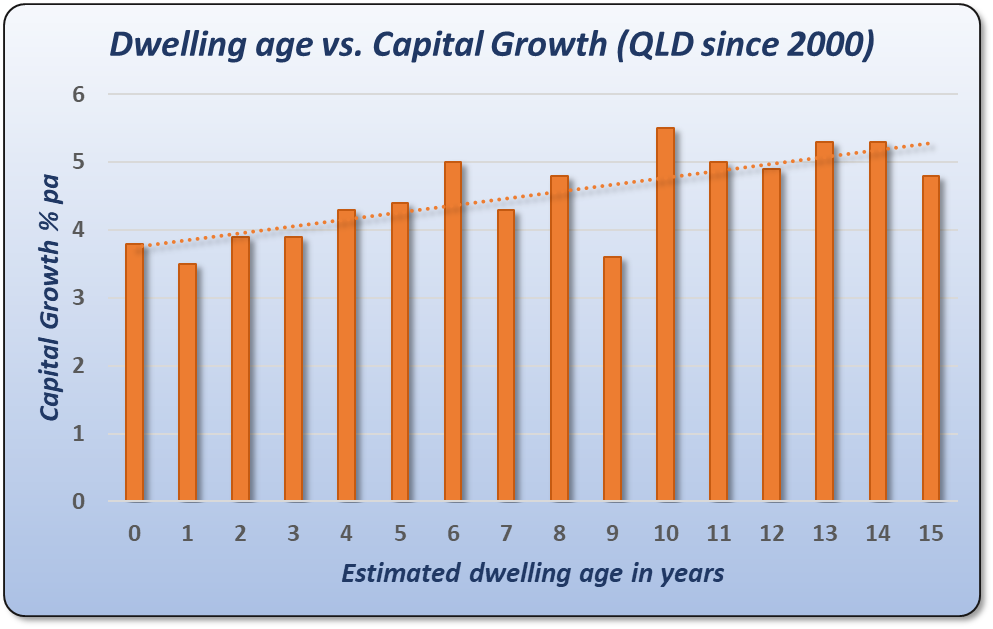
That growth chart includes both off-the-plan and established properties. Since most off-the-plan properties had zero or negative growth, they have dragged the curve on the chart lower. Clearly, established properties had to outperform new properties to create any upward movement at all.
And look at the Sydney growth curve. It’s hard to believe that over the 4-year period from 2015 there were any units that didn’t have some kind of growth.
QLD dwelling age vs. capital growth
The next chart shows the relationship between capital growth and the age of the dwelling.

The left vertical axis shows the capital growth as a percentage per annum. The bottom horizontal axis shows the estimated age of dwellings involved.
The trend line is the dotted line across the top of the bars. It shows an approximation for the relationship between age and capital growth. As you can see it goes up from left to right. That means, the older the property is, the better the capital growth rate.
Mooloolaba
The following chart shows the sales of vacant land in Mooloolaba in the Sunshine Coast for the last 40 years.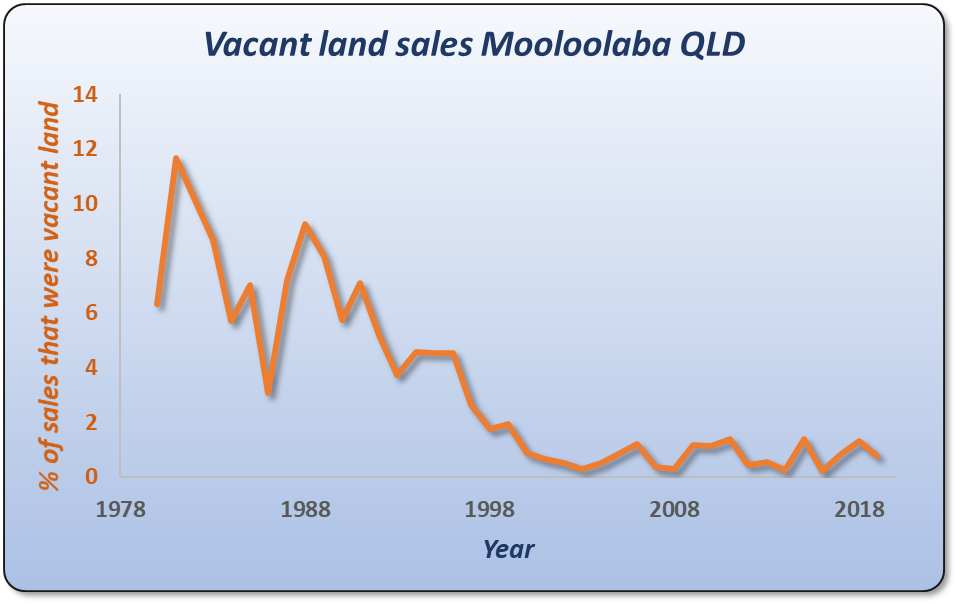
The chart shows vacant land sales as a percentage of all sales. This is another way in which we can see how much new property is coming onto the market. You can see that there was a lot in the 80s and 90s, but by the turn of the century Mooloolaba had been built out already and the number of sales of vacant land was typically less than 1%.
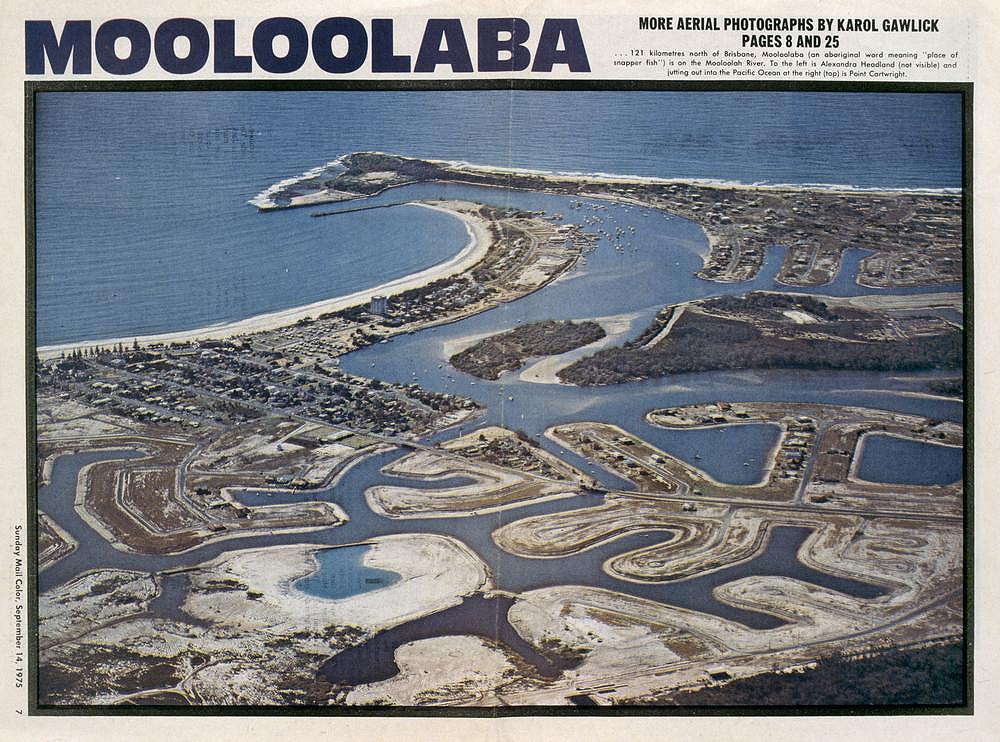
Here’s a picture of Mooloolaba from the air just before all these vacant land sales. This photo appeared in the Sunday Mail newspaper in September 1975. Notice a lot of the land has been cleared ready for new dwellings.
And here’s a more recent photo of Mooloolaba.
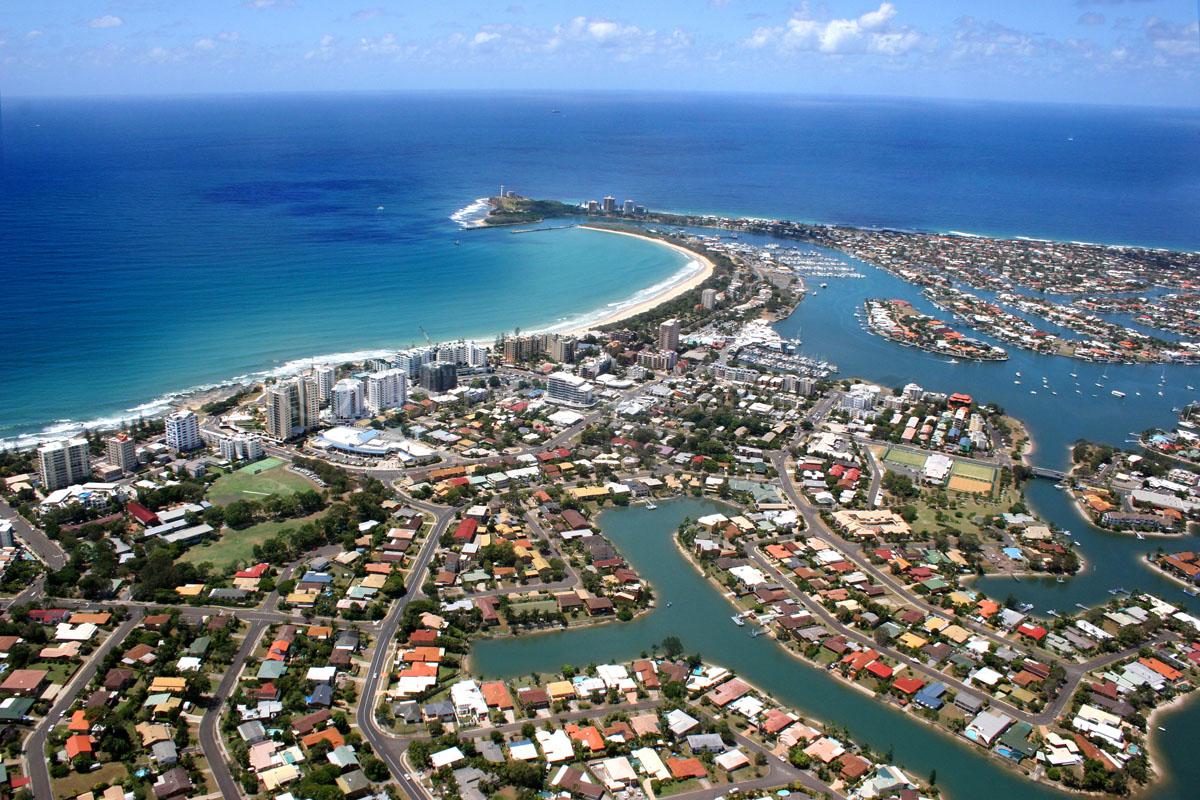
Even the land that wasn’t cleared has houses on it now. If you want to build a new house now, you probably need to knock down an existing one. How did all this new property affect price growth in Mooloolaba?
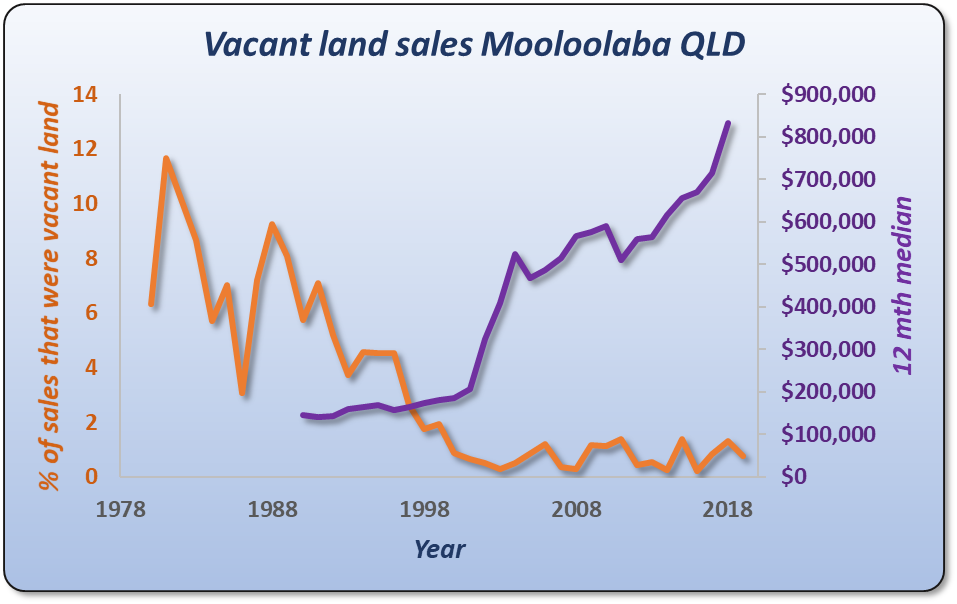
The purple line shows the 12-month median from 1990 to today. You can see how flat the growth started out for about 10 years up until the turn of the century when most of the vacant land dried up. And that’s when prices took off.
Pimpama
Not only does new property perform poorly on its own, but it’s usually accompanied by lots of other new property which creates over-supply and growth is subdued. Here is one of the worst examples of the over-supply issue in QLD right now.
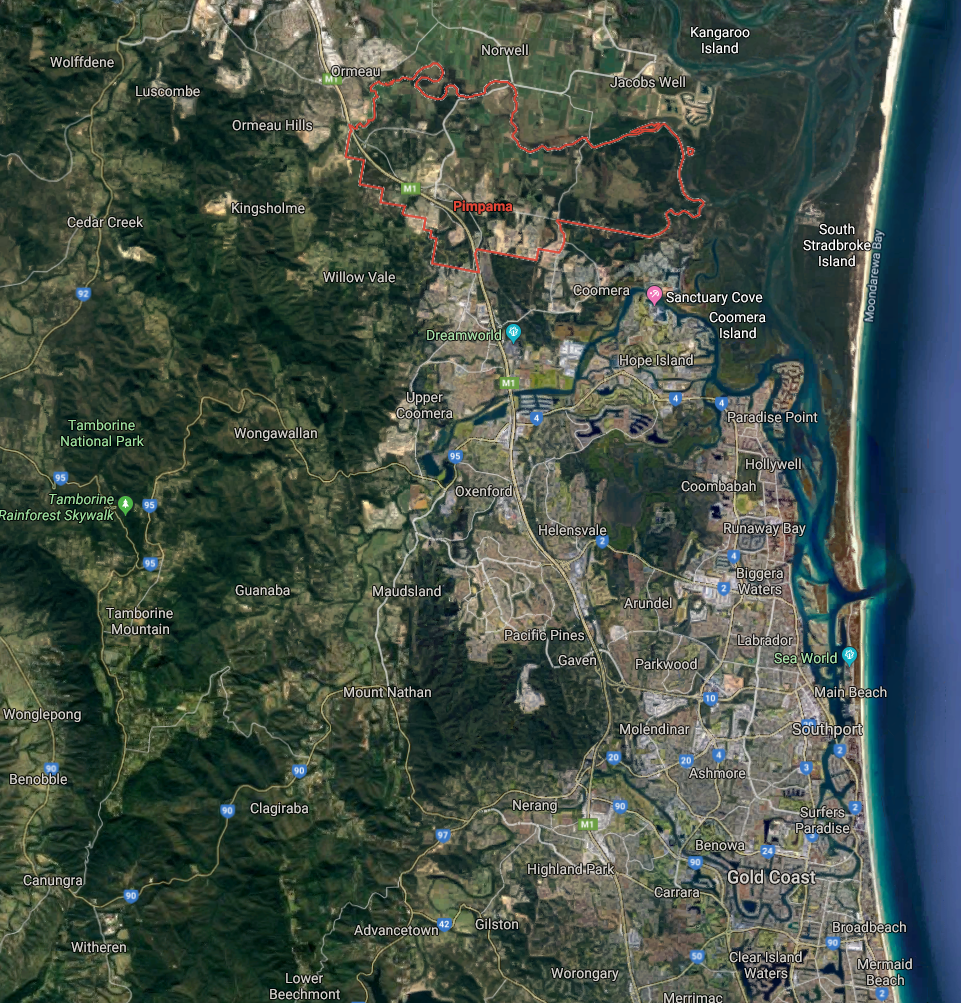
Pimpama.
It sits between Brisbane and the Gold Coast. And currently its largely undeveloped land.
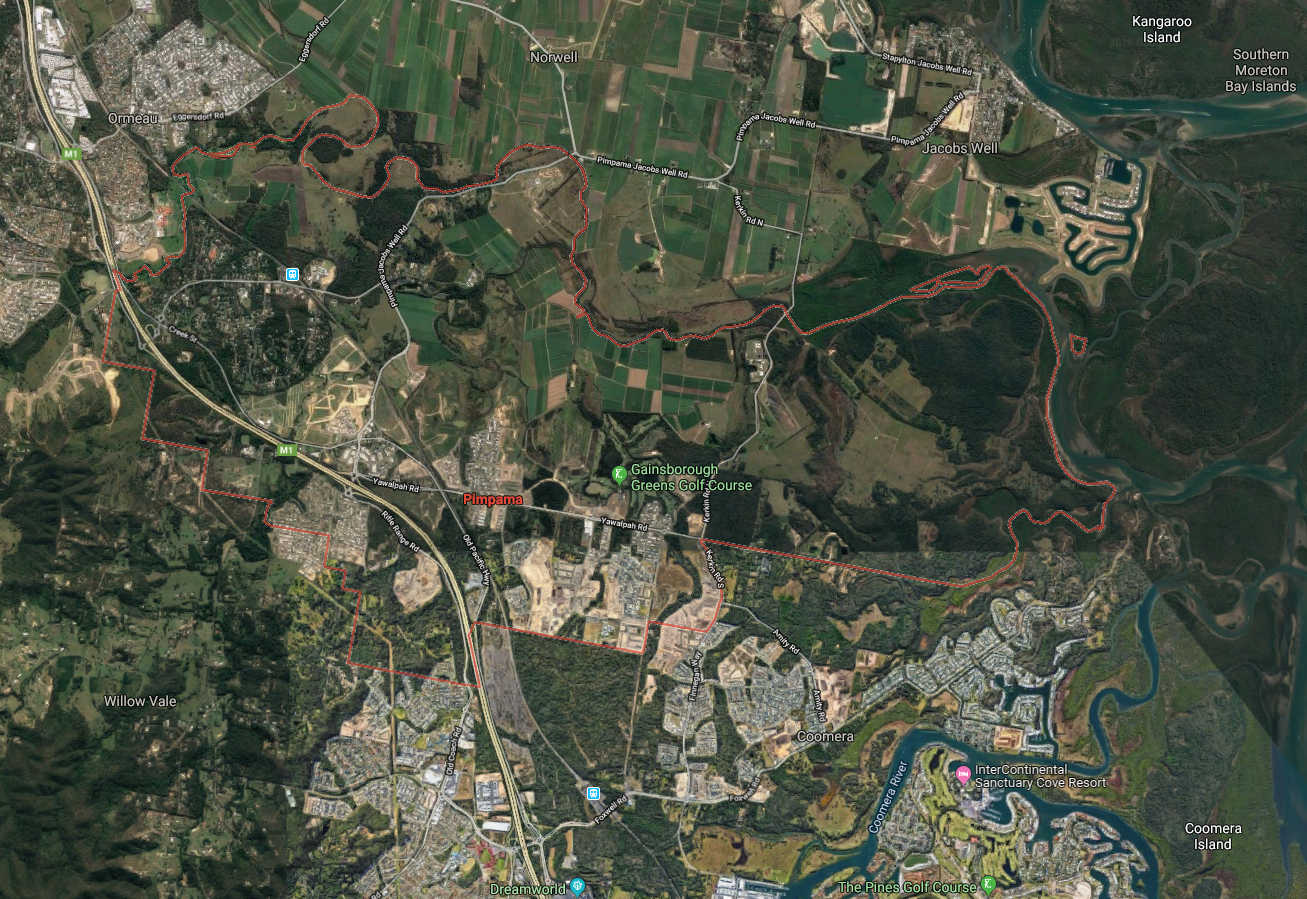
You can see in this image the townships that have been built out to the south and north west. But Pimpama is largely undeveloped.
Zooming in a little further…
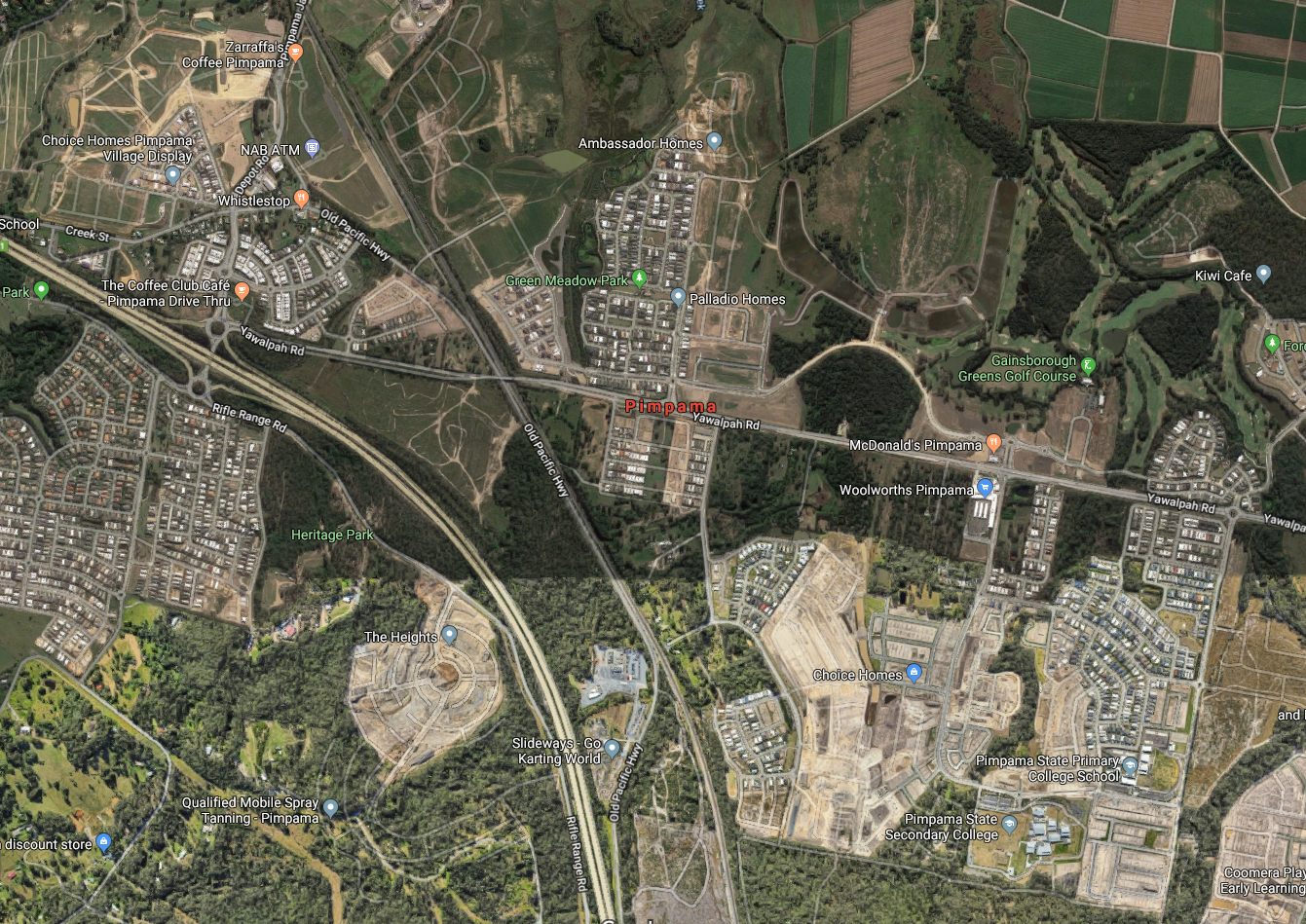
We can see loads of brown patches. This is where developers have cleared trees to chop up fresh blocks of land for sale. If we zoom in more…
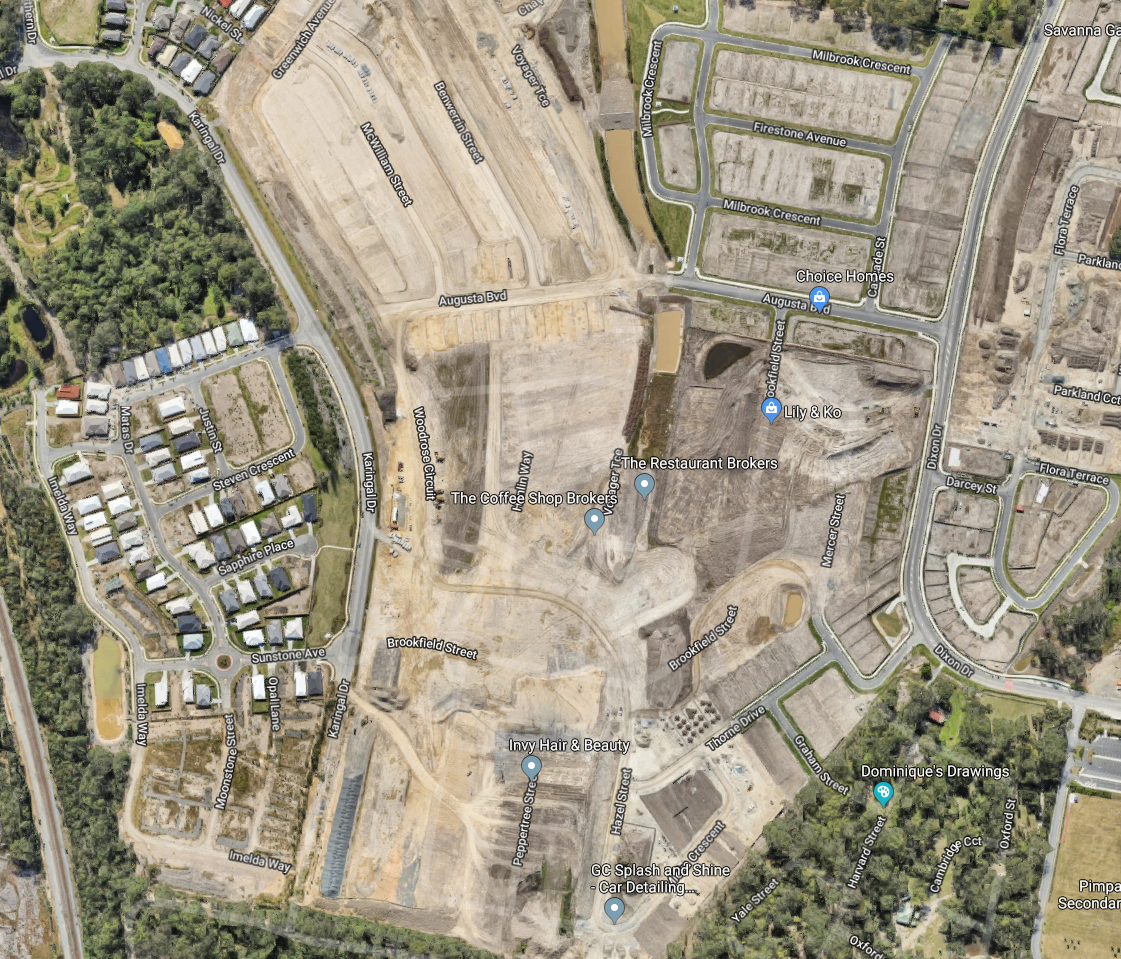
…we can see the subdivisions and some of the new houses being knocked up already.
This kind of thing is called a “growth corridor” by developers. But it’s a nightmare to investors. Steer clear of this sort of thing if you want any capital growth.
“What developers call a growth corridor; investors should call a supply corridor”
Here’s that vacant land chart again…
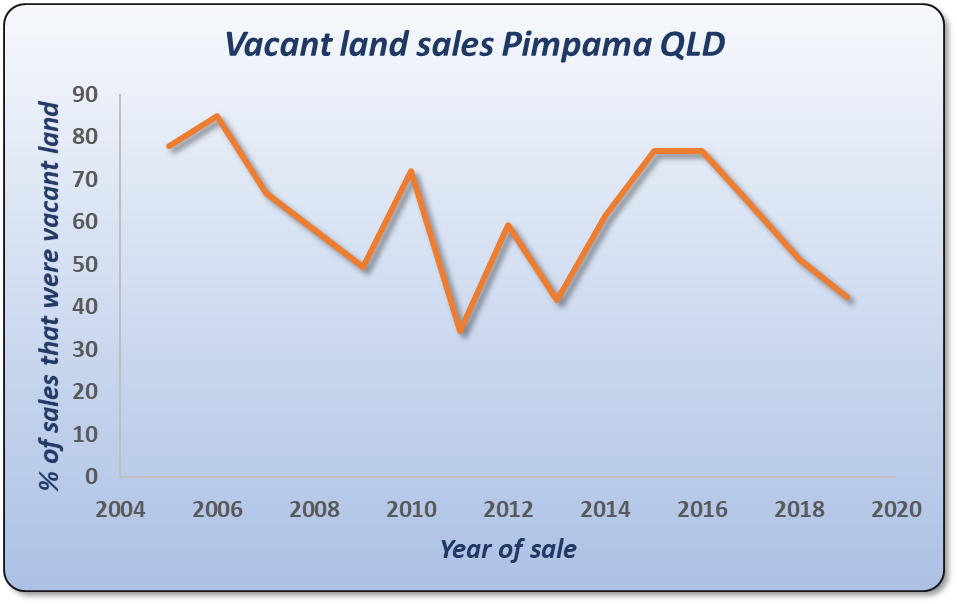
Have a close look at the left axis. It goes as high as 85% of all sales being vacant land. You saw how flat the growth was for Mooloolaba before. At its peak, Mooloolaba never got above 20% of sales were vacant land.
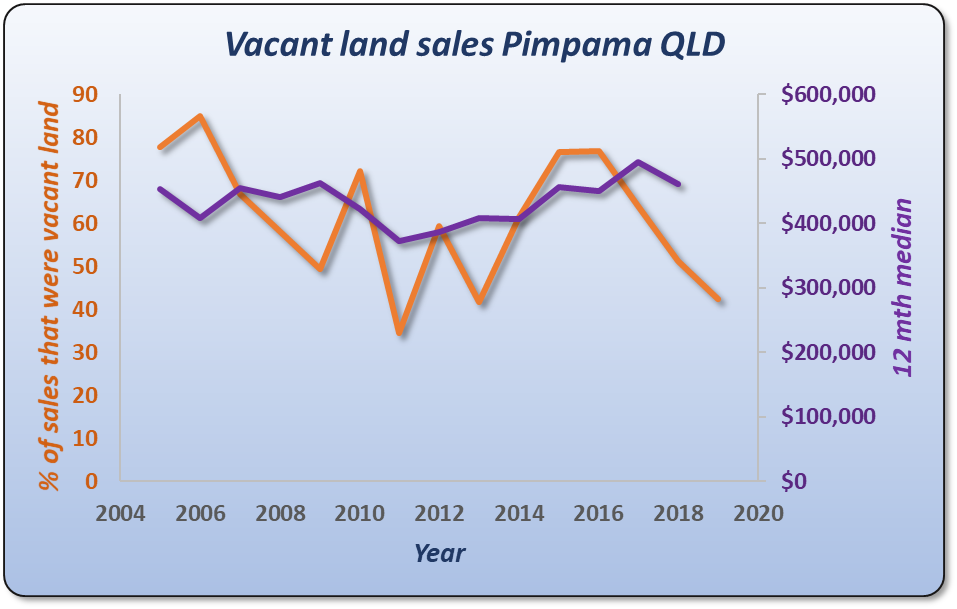
There has been effectively no capital growth in Pimpama since 2005 which is when the new properties started popping up.
Conclusion
I make no money whether investors buy new or old. The most vehement objectors I get to this topic are sellers of new. My recommendation is purely based on what the logic suggests, what the maths proves to be true and of course what the data confirms.
“New property underperforms old”
Now, having said all that, one good thing about “new” is the cash-flow. So, they may suit investors entering retirement and looking to replace their salary. But for investors looking to improve their net wealth, aim for old.
This was topic #3 in the Expert Busting series from Jeremy Sheppard. You can see more on the Select Residential Property website.
....................................................................................
 Jeremy Sheppard is head of research at DSRdata.com.au.
Jeremy Sheppard is head of research at DSRdata.com.au.
DSR data can be found on the YIP Top suburbs page.
Click Here to read more Expert Advice articles by Jeremy Sheppard
Disclaimer: while due care is taken, the viewpoints expressed by contributors do not necessarily reflect the opinions of Your Investment Property.